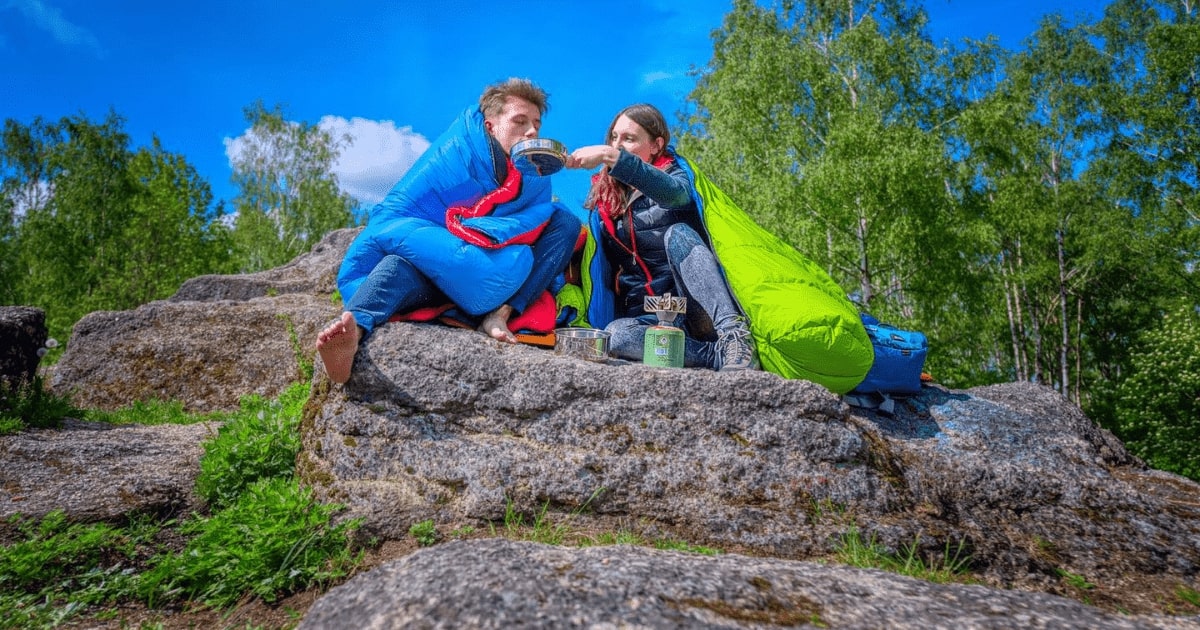Feather sleeping bags are the best sleeping bags. Any experienced mountaineer or more demanding hiker will tell you that. However, there are also differences between feather weights and choosing the right one for your activities may not be easy. Let's take a look together at how to choose a down sleeping bag and how to take care of it so that it lasts as long as possible.

Why Do You Put Feathers in a Sleeping Bag
Down sleeping bags will keep you warm even in temperatures well below zero and at the same time will not weigh more than 1.5 kg. Compared to synthetic materials, which are mainly used to fill cheaper sleeping bags, this is a striking difference. A down sleeping bag weighing 1.3 kg will keep you warm at -10 °C, but a synthetic one will weigh twice as much.
Feather sleeping bags last many times longer and do not lose their thermal insulation properties if handled properly. Sleeping bags filled with synthetic materials fail with use and cannot be restored, so they gradually lose their functionality. The washing machine will last you for years and the filling can always be refilled if necessary.
TIP: Did you know that Outdoor KWAK is the only Czech manufacturer that does it use a nanomembrane in sleeping bags?
How Down in a Sleeping Bag Works
The feathers in the sleeping bag act as an expansion medium that fills with air. The more air it can hold, the more air you heat with your body and the more it insulates. This property is called a loft.
Loft is different for different types of feathers. In general, the highest quality down achieves the maximum loft, but it takes a long time for it to take in air after unpacking the sleeping bag.
For optimal function, mixtures of down and feathers are therefore used, with each component having a different function. The down absorbs air and insulates, the feathers form a support (loft) and maintain the life of the down.
The most commonly used mixtures are:
- 85:15
- 90:10
- 95:5
The ratio 90:10 is most often used, which is the best compromise between insulation and the rate at which the sleeping bag takes up its original volume after unpacking.
Duck or Goose Down?
In general, goose down is of better quality and insulates better. Sleeping bag you probably won't find a pure duck feather on the market today, but you can still buy cheaper sleeping bags with a mixture of duck and goose down.
Duck feathers are less insulating and give off a specific smell similar to ammonia when wet, so duck feathers should be avoided.
Selection of a Sleeping Bag according to Temperature and Purpose
The most important question is where and when you will sleeping bag use. It makes a big difference whether you use a sleeping bag twice a year in a cabin or spend three weeks hiking high mountains with it.
Sleeping bags are divided into summer, three-season and winter.
Tip: We recommend a sports bottle with antibacterial treatment for a more comfortable hike and trips.</ strong>
Summer Down Sleeping Bag
Summer sleeping bags are the lightest and the best quality down ones weigh well under 1 kg. Our ultralight summer sleeping bag KWAK Rosnička , which is especially suitable for cycling and summer camping, weighs only 640 g.
You can sleep comfortably in a summer sleeping bag in temperatures of up to 5 °C, in lower temperatures you would already be cold. Summer sleeping bags are cheaper than three-season sleeping bags because they use the least amount of feathers.
|
Pros of a summer sleeping bag |
Cons of a summer sleeping bag |
|
✅ Low weight |
❌ The lowest temperature comfort |
|
✅ Lower price (little insulation) |
❌ Can only be used in summer |
|
✅ Small volume after packing |
❌ Worse selection than three-season |
Three-Season Down Sleeping Bag - Sleeping Bags for the Whole Season
Three-season sleeping bags are the most popular because they have the widest range of uses. Sleeping bag with nanomaterial KWAK Kuňka you will keep you warm in spring, summer and autumn, and you will sleep comfortably in it even in temperatures around -2 °C (women), or -9 °C (men).
|
Pros of a three-season sleeping bag |
Cons of a three-season sleeping bag |
|
✅ The best price/performance ratio |
❌ More expensive than summer |
|
✅ Use for most of the year |
❌ Not until the harsh winter |
Winter Down Sleeping Bag
Winter down jackets are specially made for extremely low temperatures, especially in the mountains and for winter camping. They provide the best thermal comfort, for women up to -5 °C and for men up to -12 °C. KWAK Skokan sleeping bag is a professional feather , which will keep you warm enough, even if it is relatively light (it weighs only 1350 g for a height of 170 cm).
Tip: We recommend packing socks that destroy odor for your travels.</p >
How to Choose the Length of the Sleeping Bag?
Sleeping bags differ in length and amount of filling. Manufacturers and sellers state sleeping bag measurements differently, some state the total length of the sleeping bag, others the recommended height.
In general, the sleeping bag should be 15 to 30 cm more than your height. We offer sleeping bags for body heights up to 170 cm, 185 cm and 200 cm.
Does a Down Sleeping Bag Stop Working when It Gets Wet?
The main disadvantage of feathers used to be the danger of the feathers getting wet, which become sticky with moisture and cease to insulate. Today it is no longer such a problem. A number of manufacturers use water-resistant or water-repellent materials on the surface of the sleeping bag, which do not allow moisture to reach the feathers.
Nanofiber Membrane in Sleeping Bag
#produkty#https://www.nanospace.store/sleeping-bags/
Czech outdoor company KWAK has gone the longest in feather protection , which built a nanofiber membrane into its down sleeping bags.
Tip: Read an article about how sports clothing works against odor.
The membrane is 100% windproof and completely hydrophobic (repels water). It has an extremely low basis weight, high vapor permeability and high water column reaches 12,000 mm.
The upper part of the nanomembrane is protected by a hydrophobic DWR treatment with a lotus effect, which prevents dust and dirt from sticking to the surface of the sleeping bag.
How to Properly Care for the KWAK Sleeping Bag?
Before using the sleeping bag tap so that the filling in the chambers can be distributed evenly . Do not leave the sleeping bag in a compressed state longer than absolutely necessary.
There can be problems when washing your sleeping bag. It's common for you to tear a seam or get feathers where they don't belong. So don't expect the sleeping bag to look like new when you take it out of the washing machine. So consider washing as a last resort.
If you decide to wash the sleeping bag, we recommend washing at 30 °C with three sneakers for the sportswear program. Wring several times. The first time at 400 revolutions and then max. at 600 revolutions. It is not advisable to use chemical agents, it will be better if you invest in special agents designed for washing feathers .
Drying on a heater or outside in the sun is not recommended, as it may happen that your sleeping bag becomes stale after a few days. If your sleeping bag does not smell, bit will be better if you dry the sleeping bag in a dryer with three balls and with scented wipes dryer. The temperature of the hot drying air must not exceed 50 °C.
It is recommended to tap the sleeping bag after drying it for the first time so that the feathers are dispersed evenly.
How to carry a sleeping bag in a compression pack
You want to go on a trip or hike with as little volume as possible on your back, so pack your sleeping bag in a compression bag. When packing, don't follow your intuition and sleeping bag do not fold or roll tightly.
During folding, sharp and strained bends occur, in which the sleeping bag is more stressed, the seams loosen and the delicate feathers break.
It is best to stuff the sleeping bag into a compression pack without any slack or storage.
Long-term storage of a down sleeping bag
Use the compression pack only when traveling, but immediately remove the sleeping bag from it at home. Store the sleeping bag ideally spread lengthwise, or hung on a hanger. Ventilate the sleeping bag thoroughly before storing it, ideally leave it unzipped for a few days at home on the ground.



